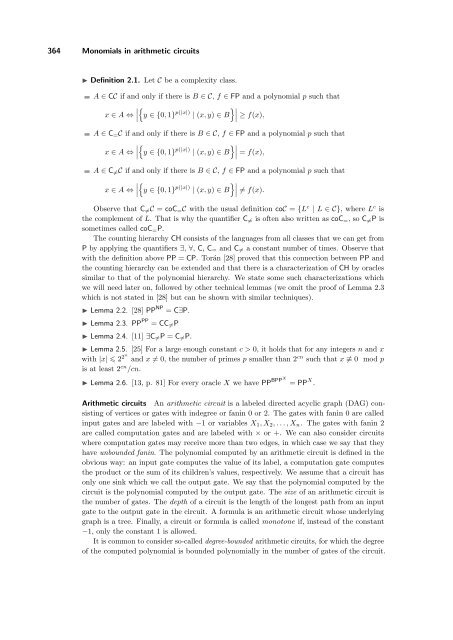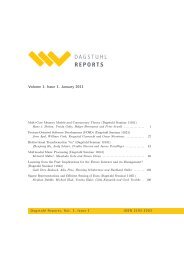Complete problems in the counting hierarchy - DROPS - Schloss ...
Complete problems in the counting hierarchy - DROPS - Schloss ...
Complete problems in the counting hierarchy - DROPS - Schloss ...
You also want an ePaper? Increase the reach of your titles
YUMPU automatically turns print PDFs into web optimized ePapers that Google loves.
364 Monomials <strong>in</strong> arithmetic circuits<br />
◮ Def<strong>in</strong>ition 2.1. Let C be a complexity class.<br />
A ∈ CC if and only if <strong>the</strong>re is B ∈ C, f ∈ FP and a polynomial p such that<br />
��<br />
�<br />
x ∈ A ⇔ � y ∈ {0, 1} p(|x|) ��<br />
��<br />
| (x, y) ∈ B ≥ f(x),<br />
A ∈ C=C if and only if <strong>the</strong>re is B ∈ C, f ∈ FP and a polynomial p such that<br />
��<br />
�<br />
x ∈ A ⇔ � y ∈ {0, 1} p(|x|) ��<br />
��<br />
| (x, y) ∈ B = f(x),<br />
A ∈ C�=C if and only if <strong>the</strong>re is B ∈ C, f ∈ FP and a polynomial p such that<br />
��<br />
�<br />
x ∈ A ⇔ � y ∈ {0, 1} p(|x|) ��<br />
��<br />
| (x, y) ∈ B �= f(x).<br />
Observe that C�=C = coC=C with <strong>the</strong> usual def<strong>in</strong>ition coC = {L c | L ∈ C}, where L c is<br />
<strong>the</strong> complement of L. That is why <strong>the</strong> quantifier C�= is often also written as coC=, so C�=P is<br />
sometimes called coC=P.<br />
The count<strong>in</strong>g <strong>hierarchy</strong> CH consists of <strong>the</strong> languages from all classes that we can get from<br />
P by apply<strong>in</strong>g <strong>the</strong> quantifiers ∃, ∀, C, C= and C�= a constant number of times. Observe that<br />
with <strong>the</strong> def<strong>in</strong>ition above PP = CP. Torán [28] proved that this connection between PP and<br />
<strong>the</strong> count<strong>in</strong>g <strong>hierarchy</strong> can be extended and that <strong>the</strong>re is a characterization of CH by oracles<br />
similar to that of <strong>the</strong> polynomial <strong>hierarchy</strong>. We state some such characterizations which<br />
we will need later on, followed by o<strong>the</strong>r technical lemmas (we omit <strong>the</strong> proof of Lemma 2.3<br />
which is not stated <strong>in</strong> [28] but can be shown with similar techniques).<br />
◮ Lemma 2.2. [28] PP NP = C∃P.<br />
◮ Lemma 2.3. PP PP = CC�=P<br />
◮ Lemma 2.4. [11] ∃C�=P = C�=P.<br />
◮ Lemma 2.5. [25] For a large enough constant c > 0, it holds that for any <strong>in</strong>tegers n and x<br />
with |x| � 22n and x �= 0, <strong>the</strong> number of primes p smaller than 2cn such that x �≡ 0 mod p<br />
is at least 2cn /cn.<br />
◮ Lemma 2.6. [13, p. 81] For every oracle X we have PP BPPX<br />
= PP X .<br />
Arithmetic circuits An arithmetic circuit is a labeled directed acyclic graph (DAG) consist<strong>in</strong>g<br />
of vertices or gates with <strong>in</strong>degree or fan<strong>in</strong> 0 or 2. The gates with fan<strong>in</strong> 0 are called<br />
<strong>in</strong>put gates and are labeled with −1 or variables X1, X2, . . . , Xn. The gates with fan<strong>in</strong> 2<br />
are called computation gates and are labeled with × or +. We can also consider circuits<br />
where computation gates may receive more than two edges, <strong>in</strong> which case we say that <strong>the</strong>y<br />
have unbounded fan<strong>in</strong>. The polynomial computed by an arithmetic circuit is def<strong>in</strong>ed <strong>in</strong> <strong>the</strong><br />
obvious way: an <strong>in</strong>put gate computes <strong>the</strong> value of its label, a computation gate computes<br />
<strong>the</strong> product or <strong>the</strong> sum of its children’s values, respectively. We assume that a circuit has<br />
only one s<strong>in</strong>k which we call <strong>the</strong> output gate. We say that <strong>the</strong> polynomial computed by <strong>the</strong><br />
circuit is <strong>the</strong> polynomial computed by <strong>the</strong> output gate. The size of an arithmetic circuit is<br />
<strong>the</strong> number of gates. The depth of a circuit is <strong>the</strong> length of <strong>the</strong> longest path from an <strong>in</strong>put<br />
gate to <strong>the</strong> output gate <strong>in</strong> <strong>the</strong> circuit. A formula is an arithmetic circuit whose underly<strong>in</strong>g<br />
graph is a tree. F<strong>in</strong>ally, a circuit or formula is called monotone if, <strong>in</strong>stead of <strong>the</strong> constant<br />
−1, only <strong>the</strong> constant 1 is allowed.<br />
It is common to consider so-called degree-bounded arithmetic circuits, for which <strong>the</strong> degree<br />
of <strong>the</strong> computed polynomial is bounded polynomially <strong>in</strong> <strong>the</strong> number of gates of <strong>the</strong> circuit.













